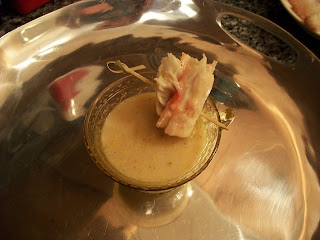
My friend whipped up this incredibly comprehensive list of sauces a few years ago. As the days grow shorter and the weather becomes colder, what better to do than get cooking and make some wonderfully comforting fare featuring these French classics?
Bon appetit!
Classic French SaucesBéchamel or
Basic White Sauce Base – light roux – butter and flour cooked together
Liquid – milk
Variations: Chivry – with herb essence added
Mornay – with cheese
Aurore – with tomato paste
Parisienne – enriched with egg yolks and cream
Veloute – using fish/chicken/veal stock instead of milk – best to simmer for up to 2 hours after preparation if possible, but not absolutely necessary
Keys: Use only a heavy-bottomed (enamel, stainless steel, pyrex, copper) saucepan – no aluminum as it will scorch and discolor the sauce
Blend flour slowly into butter at low heat, stirring constantly – do not add all at once
Milk (or stock) must be heated before being added
Thickness of sauce is in direct relation to amount of flour in proportion to amount of liquid
Thin sauce or soup base – 1 Tblsp flour per cup of liquid
Medium general purpose – 1 ½ Tblsp flour per cup of liquid
Thick sauce – 2 Tblsp flour per cup of liquid Soufflé base – 2 Tblsp flour per cup of liquid
Béchamel – 2 cups, medium thickness
You need: Heavy-bottomed 6-cup saucepan
2 Tblsp butter
3 Tblsp flour wooden spatula or spoon
2 cups milk and ¼ tsp salt heated to the boil in small saucepan
wire whisk
salt & white pepper
In the saucepan melt the butter over low heat. Blend in the flour, and cook slowly, stirring, until the butter and flour froth together for two minutes without coloring. This is a white roux. Remove the roux from heat. As soon as roux has stopped bubbling, pour in all the hot liquid at once. Immediately beat vigorously with a wire whisk to blend liquid and roux, gathering in all the bits of roux from the edges of the pan. Set saucepan over moderately high heat and stir with whisk until sauce comes to a boil. Boil for 1 minute, stirring. Remove from heat and beat in salt & pepper to taste.
Chivry – this is a béchamel sauce with the addition of a herb essence and fresh herbs
You need, in addition to béchamel sauce:
1 cup dry white wine or 2/3 cup dry vermouth
4 Tblsp minced fresh chervil, tarragon and parsley OR 2 Tblsp if dry herbs
2 Tblsp minced shallots
3-4 Tblsp additional minced fresh herbs
1-2 Tblsp softened butter
Place wine, 4 Tblsp herbs and shallots in a saucepan and boil slowly for 10 minutes, reducing to about 3 Tblsp. This is now a herb essence. Strain the essence into the béchamel sauce, pressing the juice out of the herbs. Simmer for 2-3 minutes. Off heat, just before serving, stir in the butter.
Sauce Brunes or
Basic Brown Sauce Base – dark roux – animal fat and flour cooked together Liquid – meat stock
Variations: Sauce Ragout – same as below, with giblets, bones and meat trimmings included along with lean bacon, and 1 cup white or red wine added to the beef stock
Sauce VenaisonSame as Sauce Ragout, with ½ cup red currant jelly and ½ cup whipping cream beaten into it before serving
Keys: Same as for béchamel
Even though a darker roux is required for brown sauce – the roux MUST be cooked slowly and evenly – if flour is burned, it will not thicken the sauce properly and will taste unpleasant
Brown sauces must be simmered for at least two hours
Can be refrigerated for several days and frozen for several weeks – let cool beforehand
Sauce Brune or
Demiglace – about 1 quart
You need: Heavy-bottomed 2-quart saucepan
1/3 cup each – finely diced carrots, onions and celery 3 Tblsp diced lean bacon (lardon or pancetta – European style bacon)
6 Tblsp rendered fresh pork fat (can use bacon fat from American style bacon if smoky flavor is desired)
4 Tblsp flour
Wooden spatula or spoon
Wire whisk 6 cups boiling brown stock – beef bouillon 2 Tblsp tomato paste
A medium herb bouquet: 3 parsley sprigs, 1 bay leaf, and ¼ tsp thyme tied in cheesecloth
Cook the vegetables and bacon slowly in the fat for 10 minutes.
Blend the flour into the vegetables and stir continually over moderately low heat for 8-10 minutes, until the flour slowly turns a golden nut brown. Remove from heat. With a whisk, immediately blend all the boiling liquid at once. Beat in the tomato paste. Add the herb bouquet. Simmer slowly, partially covered, for 2 hours or more, skimming off fat as necessary. You should end up with sauce that is thick enough to coat a spoon lightly. Add salt & pepper to taste. Strain sauce, pressing juice out of vegetables. Degrease thoroughly.
Sauces Tomate –
Tomato SauceThis sauce starts with an olive oil roux. There is no mystery to it – it is a thick, concentrated tomato sauce with a Mediterranean flavor that I like a lot. It can be refrigerated or frozen. Coulis de Tomates a la Provencale – about 2 cups
You need: Heavy-bottomed 3-quart saucepan
1/3 cup finely minced shallots
2 Tblsp olive oil
2 Tsp flour
3 lbs ripe red tomatoes – peeled, seeded and juiced, chopped
1/8 tsp sugar
2 cloves mashed garlic
Medium herb bouquet – 4 parsley sprigs, 1 bay leaf, and ¼ tsp thyme tied in cheesecloth
1/8 tsp fennel
1/8 tsp basil
small pinch saffron
small pinch coriander
¼ tsp dried orange peel
½ tsp salt
1-2 Tblsp tomato paste if necessary
Salt & Pepper
Cook the shallots and the olive oil slowly together for about 10 minutes, until shallots are tender but not browned. Stir in the flour and cook slowly for 3 minutes without browning. Stir in the tomatoes, sugar, garlic, herbs and seasonings. Cover pan and cook slowly for 10 minutes. Then uncover and simmer for about half an hour, adding spoonfuls of tomato juice or water if sauce is too thick and seems at risk of scorching. The sauce is done when it tastes thoroughly cooked and is thick enough to form a mass in the spoon. Remove the herb bouquet. Stir in 1-2 Tblsp of tomato paste for color if desired and simmer 1-2 minutes. Add salt & pepper to taste.
HollandaiseBase – egg yolks and lemon juice – acid softens and prepares yolks to accept and absorb butter
Liquid – butter
Variations: Bearnaise – wine and herb reduction used instead of lemon juice
Mousseline – ½ cup whipping cream folded into hollandaise before serving
Maltaise – half of lemon juice replaced with orange juice – orange juice and grated orange peel beaten in before serving
Sauce Vin Blanc – white wine/fish stock used instead of lemon juice
Keys: Egg yolks must be heated slowly and gradually, preferably in a double-boiler – too sudden heat will make them granular, and overcooking will scramble them
Butter must be added very gradually, giving yolks time to absorb before more is presented Maximum amount of butter that can be absorbed per yolk is about 3 oz – do not exceed or sauce will curdle
Hollandaise – 1- 1 ½ cups
You need: 6-8 oz butter (1 ½ - 2 sticks)
Small saucepan
Medium weight 4-6 cup saucepan or double boiler with 4-6 cup bowl
Wire whisk
3 egg yolks
1 Tblsp cold water
1 Tblsp lemon juice
Big pinch of salt
1 Tblsp cold butter
A pan of cold water – to cool bottom of saucepan/double boiler if necessary
1 Tblsp cold butter
Salt & white pepper
More lemon juice
Melt the 6-8 oz butter in the small saucepan over moderate heat. Set aside. Beat the egg yolks for about 1 minute in the saucepan or double boiler bowl, until they become thick and sticky. Add the cold water, lemon juice and salt, and beat for 1 minute more. Add 1 Tblsp cold butter, but do not beat in. Place the saucepan or double boiler bowl over very low heat or barely simmering water and stir the egg yolks until they slowly thicken into a smooth cream, about 1-2 minutes. If they seem to be thickening too quickly or getting lumpy, immediately remove the pan from heat and plunge the bottom into the pan of cold water, beating the eggs to cool them. Then continue beating over heat. The eggs have thickened enough when you can begin to see the bottom of the pan between strokes, and the mixture forms a light cream on the wires of the whisk. Immediately remove from heat and beat in 1 Tblsp cold butter – this will cool the yolks and stop their cooking. Then while beating the yolks with a whisk, add the melted butter by droplets or ¼ teaspoonfuls until the sauce begins to thicken into a very heavy cream. Season to taste with salt, pepper and lemon juice.
Bearnaise Bearnaise is just like hollandaise, except instead of lemon juice, you use a wine & herb reduction. For this, you need:
¼ cup white wine vinegar
¼ cup dry white wine or dry vermouth
1 Tblsp minced shallots 1 Tblsp minced fresh tarragon or ½ Tblsp dried tarragon
1/8 tsp pepper
pinch of salt
small saucepan
Boil all ingredients in the small saucepan over moderate heat until the liquid has reduced to 2 Tblsps. Let it cool. Proceed as in making hollandaise, using wine & herb reduction instead of lemon juice. At finish, beat in another 2 Tblsp fresh minced tarragon.
 Congratulations to Matsuri, celebrating its seventh anniversary! In honor of the occasion, the fish forward restaurant housed in The Maritime Hotel is plying patrons with a Seven Deadly Sins Tasting Menu for $77.77 all throughout October--and a fanciful flight of sake pairings to accompany the transgressions is also available for an additional $37. With chef extraordinaire Tadashi Ono at the helm, the real sin would be missing out on the festivities!
Congratulations to Matsuri, celebrating its seventh anniversary! In honor of the occasion, the fish forward restaurant housed in The Maritime Hotel is plying patrons with a Seven Deadly Sins Tasting Menu for $77.77 all throughout October--and a fanciful flight of sake pairings to accompany the transgressions is also available for an additional $37. With chef extraordinaire Tadashi Ono at the helm, the real sin would be missing out on the festivities!



























